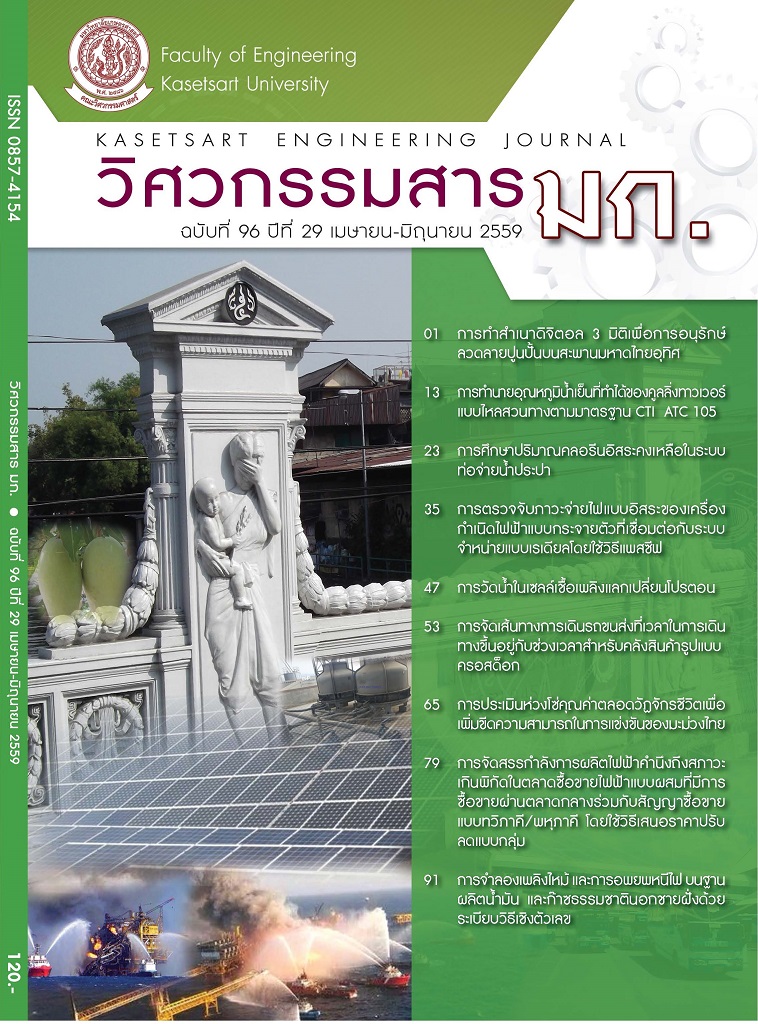การทำนายอุณหภูมิน้ำเย็นที่ทำได้ของคูลลิ่งทาวเวอร์แบบไหลสวนทางตามมาตรฐาน CTI ATC 105
Keywords:
ซีทีไอ, ภาวะนอกเหนือการออกแบบ, อุณหภูมิน้ำเย็น, CTI, off-design conditions, cold water temperatureAbstract
การทำนายอุณหภูมิน้ำเย็นที่ภาวะนอกเหนือการออกแบบ (อุณหภูมิกระเปาะเปียกบรรยากาศ และพิสัยระบายความร้อนที่ไม่ใช่ภาวะการออกแบบ) นำไปสู่การหาแอปโพรชที่สัมพันธ์กับค่าของพารามิเตอร์ตามลักษณะเฉพาะของคูลลิ่งทาวเวอร์ที่ภาวะการออกแบบ สามระเบียบวิธีทั่วไป ได้แก่ วิธีแรงม้าเบรกพัดลมคงที่ วิธีระยะพิตช์ของพัดลมคงที่ และวิธีอัตราการไหลโดยมวลของอากาศคงที่ เพื่อใช้คำนวณหาอัตราส่วนการไหลของน้ำต่ออากาศ (L/G) ภายใต้ค่ากำหนดของอุณหภูมิกระเปาะเปียก และความชื้นสัมพัทธ์ของบรรยากาศ ระเบียบวิธีทั้งสามนำมาใช้ โดยการสมมติค่าอุณหภูมิของอากาศอิ่มตัวทางออก (หรือค่าอัตราส่วนการไหลของน้ำต่ออากาศ) และการคำนวณซ้ำจะดำเนินต่อไปจนกว่ากำลังม้าเบรกของพัดลมที่ภาวะนอกเหนือการออกแบบนั้นเท่ากับกำลังม้าเบรกของพัดลมที่ภาวะการออกแบบ สำหรับวิธีแรงม้าเบรกพัดลมคงที่อัตราการไหลโดยปริมาตรของอากาศที่ภาวะนอกเหนือการออกแบบนั้นเท่ากับอัตราการไหลโดยปริมาตรของอากาศที่ภาวะการออกแบบ สำหรับวิธีระยะพิตช์ของพัดลมคงที่ และอัตราการไหลโดยมวลของอากาศที่ภาวะนอกเหนือการออกแบบนั้นเท่ากับอัตราการไหลโดยมวลของอากาศที่ภาวะการออกแบบสำหรับวิธีอัตราการไหลโดยมวลของอากาศคงที่การศึกษานี้พิจารณากราฟสมรรถนะการทำงานของคูลลิ่งทาวเวอร์ที่ได้มาจากการคำนวณตามวิธีระยะพิตช์ของพัดลมคงที่ ผลการวิเคราะห์ตามเทคนิคการคำนวณซ้ำดังกล่าวจะได้พิสัยระบายความร้อนจริง และอัตราส่วนการไหลของน้ำต่ออากาศจริงภายใต้ค่ากำหนดของอุณหภูมิกระเปาะเปียกบรรยากาศ ค่ากำหนดของลักษณะเฉพาะของคูลลิ่งทาวเวอร์ (ลักษณะเฉพาะของแผงขยายฟิล์มน้ำ) พิสัยระบายความร้อนจริง และอัตราส่วนการไหลของน้ำต่ออากาศจริง จากพารามิเตอร์เหล่านี้สามารถนำไปใช้หาค่าของแอปโพรชจริง และอุณหภูมิน้ำเย็นที่ทำได้ที่ภาวะนอกเหนือการออกแบบ ในที่สุดจึงสามารถพล็อตกราฟสมรรถนะของคูลลิ่งทาวเวอร์ที่ภาวะการออกแบบและภาวะนอกเหนือการออกแบบได้ กราฟสมรรถนะนี้นำเสนอด้วยอุณหภูมิน้ำเย็นที่ทำได้กับอุณหภูมิกระเปาะเปียกบรรยากาศ ซึ่งพล็อตที่ 80 100 และ 120% ของพิสัยระบายความร้อนค่าออกแบบ สำหรับ 90 100 และ 110% ของอัตราการไหลค่าออกแบบของน้ำหมุนเวียน ตามมาตรฐานของ CTI
Estimation of the Cold Water Temperatures of a Counter - Flow Cooling Tower on ATC105 - Code CTI Standard
The prediction of cold water temperature at the off-design conditions (ambient wet bulb temperature and cooling range other than design conditions) is to find an approach satisfying the cooling tower characteristic values at the design condition. There are three conventional methods namely, the constant fan BHP, the constant fan pitch, and the constant air mass flow rate are used to find the actual water to air flow ratio (L/G). On the given ambient wet bulb temperature and inlet relative humidity , all three methods can be applied by assuming the exit saturated air temperature (water to air flow ratio) and the iteration is continued until the net fan power at the off-design condition equals the net fan power at the design condition for the constant fan BHP method, the air volume flow rate at the off-design condition equals the air volume flow rate at the design condition for the constant fan pitch method, and the air mass flow rate at the offdesign condition equals the air mass flow rate at the design condition for the constant air mass flow rate method, respectively. In this study, the performance curves of cooling tower are based on the constant fan pitch method. Accordingly, the results of this iteration technique are actual range and actual water to air flow ratio. On the given ambient wet bulb temperature, given cooling tower characteristics, actual range, and actual water to air flow ratio, these parameter can be used to find an actual approach and cold water temperature at the off-design point. Finally, the performance (cold water temperature) curves of cooling tower can be plotted at the design and off-design conditions. These performance curves presenting the cold water temperature versus the ambient wet bulb temperature are plotted for 80, 100, and 120% of the design cooling range on 90, 100 and 110% of the design flow rate of circulated water which are based on CTI standards.


